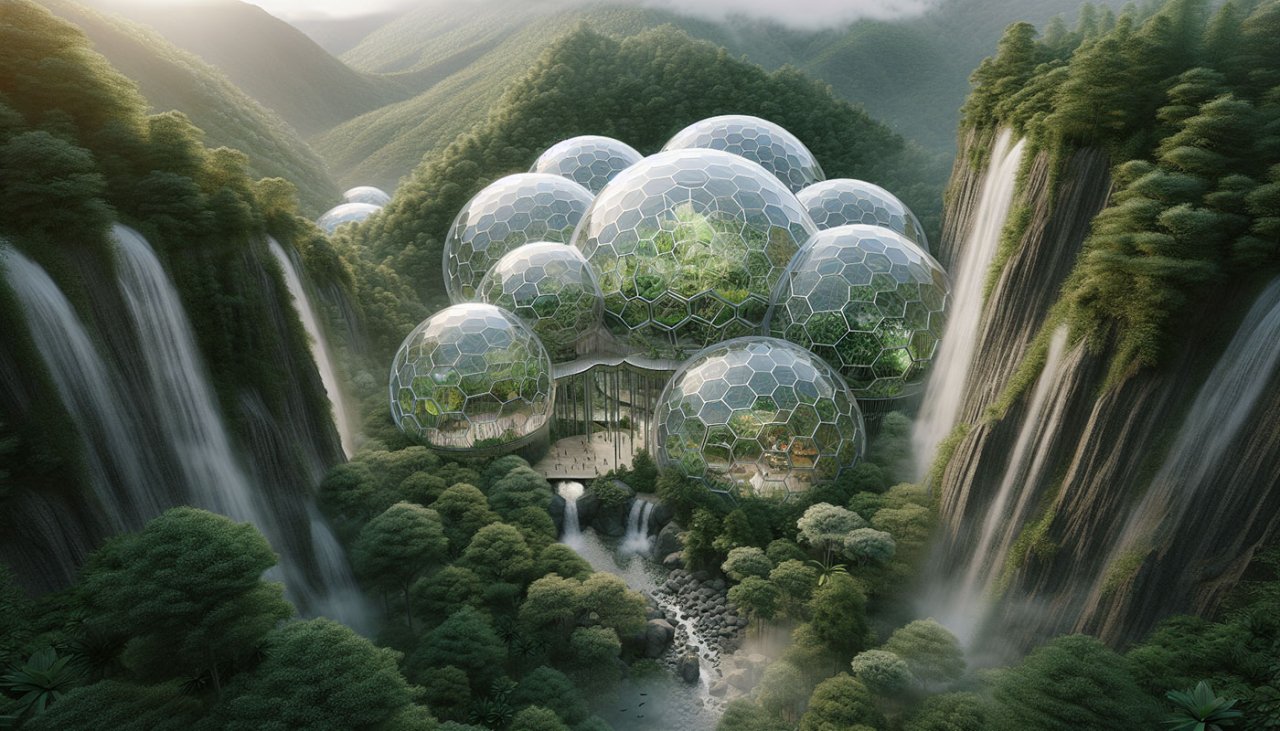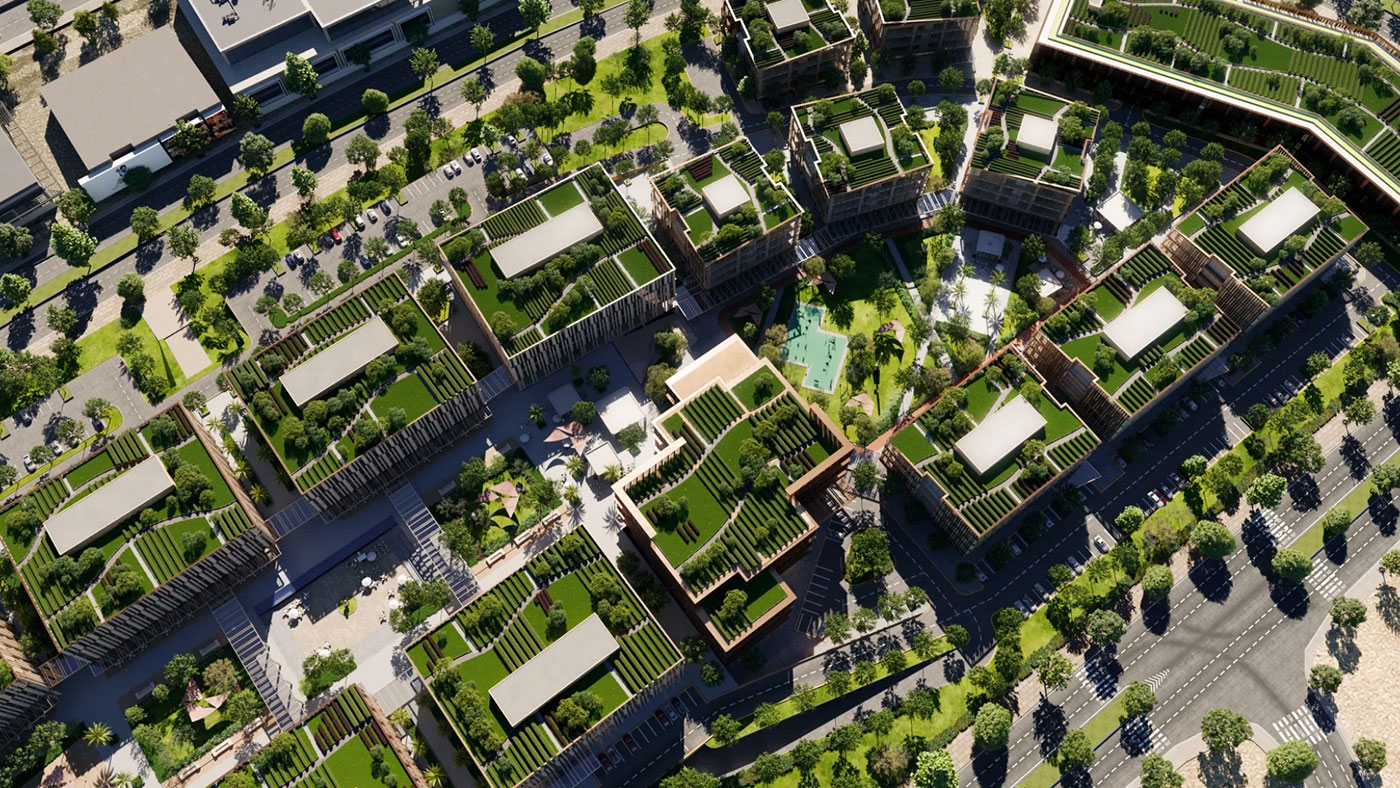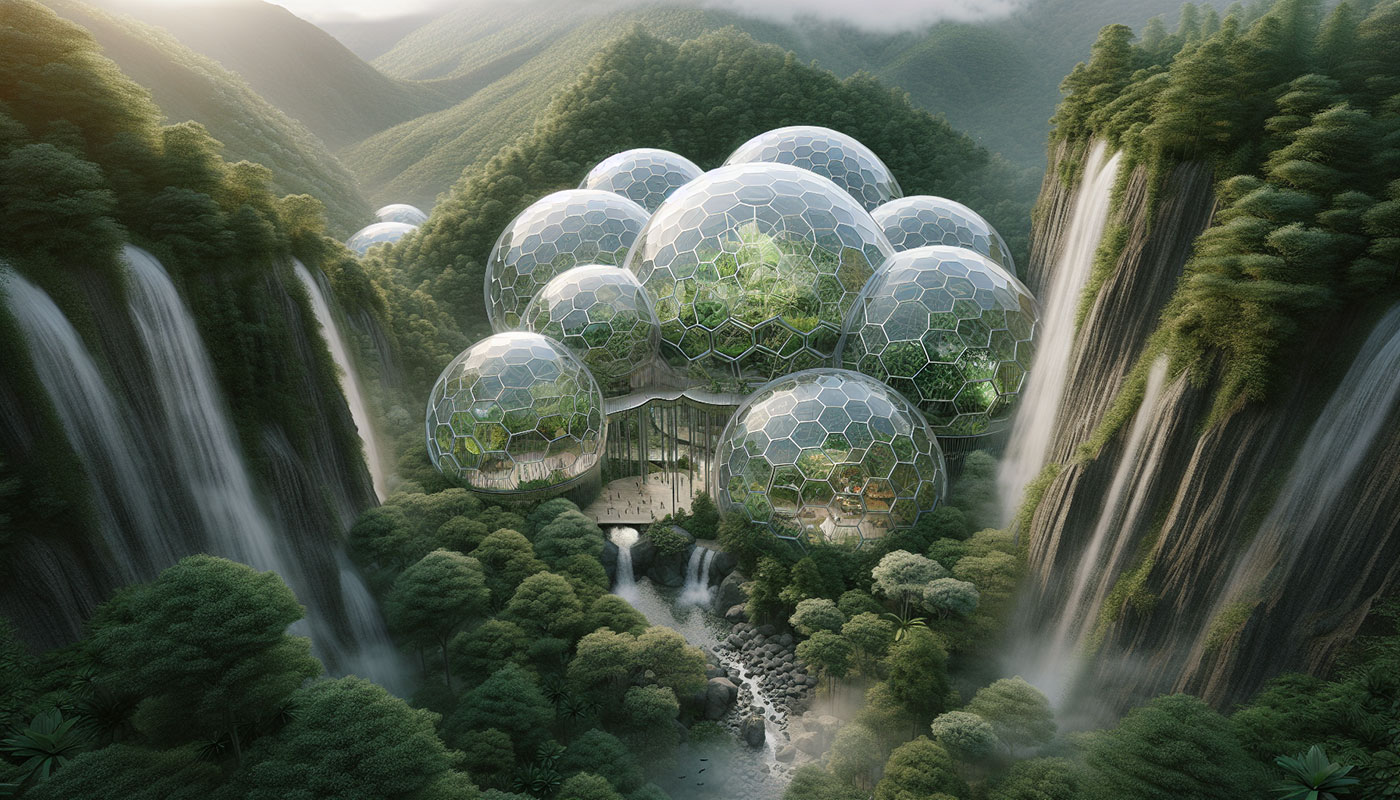Biophilic Design: How Nature-Inspired Spaces Promote Well-being

Arqsix
January 8th, 2024

Have you ever felt an inexplicable sense of calm and rejuvenation in the presence of nature? This is no mere coincidence; our innate affinity for the natural world and its profound impact on our well-being is at the heart of a design approach called “biophilic design”. By integrating elements of nature into our built environments, biophilic design not only enhances the aesthetic appeal of a space but also promotes well-being and environmental sustainability.
Why is Biophilic Design Trending Now?
 Created by Arqsix
Created by Arqsix
Biophilic design, a term popularized by the American biologist Edward O. Wilson, is an innovative design approach that seeks to foster our connection with nature. At a time when most of us spend the vast majority of our time indoors, biophilic design presents a refreshing departure from the sterile and artificial environments that typically characterize our built surroundings.
What’s the reason behind the increasing popularity of this nature-inspired design approach? The answer lies in the myriad of health benefits it offers. By integrating natural elements such as plants, natural materials, and natural light into our spaces, biophilic design has been shown to reduce stress, enhance cognitive function and creativity, and boost overall well-being. Essentially, it satisfies our innate need to connect with nature, a fundamental instinct shaped by human evolution.
People are also striving to be more and more green, which is another reason why they might be drawn towards exterior and interior spaces that have a biophilic design philosophy. We are also more isolated than ever, mostly interacting with our screens, which means less contact with real, organic materials. In a certain sense, our natural habitat has severely changed, making it incredibly artificial.
Despite the numerous advantages, biophilic design isn’t exempt from challenges and criticisms. The cost and complexity of implementing biophilic design principles, particularly in high-density urban environments, are often cited as obstacles. Nonetheless, creative solutions are starting to surface. Temporary pop-up parks in parking spaces, outdoor dining areas with temporary landscaping, and the strategic use of natural lighting to evoke nature indoors are just a few examples of how biophilic design is being implemented in urban settings.
The potential of biophilic design extends beyond individual well-being. Consider the city of New Orleans, for instance. By preserving the bayous, natural landscapes that provide essential ecosystem services, the city stands to save an estimated $23 billion per year in storm protection. These cases illustrate how biophilic design can transform spaces, promoting both individual well-being and sustainable, resilient urban environments.
Understanding Biophilic Design: Key Concepts
A comprehensive understanding of the biophilia hypothesis, the foundation of biophilic design, is crucial to appreciate its potential. First proposed by Edward O. Wilson, the biophilia hypothesis states that humans possess an inherent desire to connect with nature and other living organisms for both survival and personal satisfaction.
This connection to nature goes beyond personal preference; it’s an essential part of our well-being. Experiences of nature, whether direct or indirect, can lead to significant health benefits, including reduced stress, improved mental health, and enhanced cognitive performance. This is the premise upon which biophilic design is built.
Biophilic design is comprised of three key elements:
Nature in the Space: This refers to the incorporation of direct, physical, and ephemeral presence of nature in a space. This could include elements like plants, water bodies, or even a refreshing breeze entering through a window.
Natural Analogues: This refers to representations of nature, like images of nature or naturalistic shapes in architecture.
Nature of the Space: This refers to the spatial configurations in nature, creating spaces that evoke feelings of awe, risk, and mystery, much like how we feel when we are in natural environments.
Integrating these elements into architectural design can craft spaces that are visually appealing, comfortable, and supportive of our health and well-being. For instance, research has shown that non-visual sensory interactions with non-threatening nature, such as the sound of a bubbling brook or the smell of fresh pine, can lead to reductions in systolic blood pressure and stress hormones, improved cognitive performance, and perceived improvements in mental health and tranquility.
Ultimately, biophilic design aims to create spaces that nurture our inherent bond with nature, contributing to individual well-being and environmental sustainability.
The Elements of Biophilic Design
Delving deeper into the landscape of biophilic design, we encounter six key elements that significantly contribute to the creation of spaces that forge a deep connection with nature:
Environmental features
Natural shapes and forms
Natural patterns and processes
Light and space
Place-based relationships
Evolved human-nature relationships
Environmental features refer to direct, physical, and ephemeral presence of the natural environment in a space. This could include elements like plants, water bodies, or even a refreshing breeze entering through a window.
Natural shapes and forms, on the other hand, refer to botanical, animal, or naturalistic shapes in architecture or design, such as a building that mimics the shape of a flower or furniture that emulates the curvaceous forms of pebbles.
Natural patterns and processes involve incorporating patterns, shapes, or sequences that recur in nature, such as the spiral pattern of a nautilus shell or the honeycomb pattern of a beehive.
Light and space involve creating a balance of light and dark, open and enclosed spaces, much like what we would experience in a natural landscape or a well-designed green space.
Place-based relationships involve incorporating elements of the local ecosystems or culture into the design.
Lastly, evolved human-nature relationships involve designing spaces that cater to our innate instincts and needs, such as the need for refuge or the desire for prospect, fostering a sense of human connection.
When these elements are deliberately integrated into a design, they can generate spaces that are not only aesthetically pleasing and comfortable but also beneficial to our health and well-being.
Inspiring Examples of Biophilic Architecture
 Generated by SurferAI
Generated by SurferAI
Over the years, architects and designers worldwide have embraced the principles of biophilic design, creating structures that seamlessly integrate nature into their architecture. One such example is the Eden Project in Cornwall, a series of massive domes that house thousands of plant species from around the world. Through its innovative design, the Eden Project allows visitors to experience diverse natural environments under one roof.
Another inspiring example is the Jewel Changi Airport in Singapore. This airport features a massive indoor waterfall and a lush indoor forest, offering travelers a calming and refreshing reprieve from the stress of travel. The Jewel Changi Airport is a testament to how biophilic design can be integrated into commercial spaces to enhance user experience and well-being.
In Milan, the Bosco Verticale, or “Vertical Forest”, takes biophilic design to new heights. This pair of residential towers is home to over 900 trees, 5,000 shrubs, and 11,000 perennial plants, effectively creating a vertical forest in the heart of the city. This not only enhances the well-being of the building’s occupants but also contributes to urban biodiversity and helps combat air pollution.
These examples demonstrate the versatility and potential of biophilic design. Whether it’s a botanical garden housed in futuristic domes, an airport that feels like a tropical forest, or a high-rise residential building teeming with greenery, biophilic design can manifest in a myriad of ways, each one unique and awe-inspiring in its own right.
Why Biophilic Design Matters: Health and Environmental Benefits
 Generated by SurferAI
Generated by SurferAI
The advantages of biophilic design go beyond mere visual appeal. Numerous studies have demonstrated the positive impact of biophilic design on health. By fostering a connection with nature, biophilic design can reduce stress levels, improve psychological well-being, and enhance productivity.
Consider vegetative walls and roofs, for instance. These elements not only enhance the aesthetic appeal of a building but also act as biofilters, effectively decreasing polluted water and contributing to the preservation of natural systems in a cost-efficient manner.
The advantages of biophilic design aren’t confined to personal well-being. On a broader scale, biophilic design can contribute to urban biodiversity. By incorporating elements of the local ecosystems into design, biophilic design can create habitats for various species, contributing to the preservation of biodiversity in urban areas.
Despite the many benefits and the growing popularity of biophilic design, it is not without its challenges. Some of the challenges include:
Lack of long-term research on its benefits
Concerns about the high costs of implementing biophilic design principles
Practicality of implementing biophilic design in different types of buildings
However, with collaboration between architects, designers, and property owners, and with the adoption of sustainable practices, these challenges can be overcome, paving the way for a future where our built environments are in harmonious coexistence with nature.
The Role of Natural Materials in Biophilic Design
Natural materials are integral to biophilic design. By incorporating materials derived from nature into our built environments, biophilic design fosters a multisensory experience and connection to nature.
Consider the use of wood in interior design. Research has shown that a moderate ratio of wood in an interior space can lead to significant decreases in diastolic blood pressure and increases in pulse rate, while a decrease in brain activity was observed in large ratios (i.e., 90% coverage).
The colors we choose to incorporate into our spaces also have a significant impact on our psychological functioning. For instance, exposure to the color green prior to completing a task can enhance creativity performance, though it does not have any impact on analytical performance. This is why many biophilic designs incorporate natural colors inspired by the outdoors.
Commonly used natural materials in biophilic design include:
FSC wood
Bamboo
Linen
Cork
Ceramic
Rattan
Stone
These materials not only establish a connection to nature but also reinforce the biophilic design principles.
Natural materials in biophilic design serve more than just aesthetic purposes. By utilizing materials that are derived from or inspired by nature, biophilic design creates spaces that not only look good but also feel good, improving our well-being and fostering a stronger connection with the natural world.
Incorporating Biophilic Design in Residential and Commercial Spaces
Whether it’s a home or a commercial space, the principles of biophilic design can be integrated to create spaces that promote well-being and sustainability. For residential spaces, biophilic design can be as simple as:
Using a color palette inspired by nature
Opening windows and doors for fresh air
Incorporating natural materials like wood and stone
Decorating with plants
Welcoming natural light into the space
For commercial spaces, the application of biophilic design can be a bit more complex, but the benefits are just as significant. By implementing nature-inspired features like living walls, water features, or outdoor views, commercial spaces can enhance the productivity, well-being, and overall satisfaction of employees and customers.
Bear in mind, there’s no universal approach to incorporating biophilic design in residential and commercial spaces. The specific design interventions will depend on the specific needs of the space and its intended user group. This is where the collaboration between architects, designers, and property owners becomes crucial. By working together, they can ensure that the design is customized to the specific requirements of the project and optimized for the space.
Ultimately, regardless of whether it’s a home or a commercial space, biophilic design aims to create environments that cultivate a bond with nature, enhance well-being, and support environmental sustainability.
Biophilic Design vs. Green Architecture: Understanding the Differences
Although both biophilic design and green architecture emphasize sustainability, their approaches differ. Green architecture focuses on minimizing the ecological footprint of buildings, using techniques such as energy-efficient design, renewable energy sourcing, and sustainable material use. The goal of green architecture is to reduce the negative environmental impacts associated with the construction and operation of buildings.
Biophilic design, on the other hand, goes beyond sustainability. While it also prioritizes environmentally-friendly practices, its primary focus is on fostering a connection between people and nature within built environments. By incorporating natural elements and systems into the built environment, biophilic design draws on our inherent connection with the natural world, improving well-being, encouraging sustainability, and creating a sense of balance and peace in the built environment.
In green architecture, the emphasis is on the building’s impact on the environment. In biophilic design, the emphasis is on the impact of the building’s design on its occupants. This isn’t to suggest that one approach is superior to the other. Rather, they represent two different, but complementary, approaches to sustainable design.
In fact, many of the principles of green architecture and biophilic design overlap. For instance, both approaches emphasize the importance of natural light, efficient use of resources, and the integration of natural elements into the built environment. By combining the principles of green architecture and biophilic design, architects and designers can create spaces that are not only sustainable but also promote well-being and a connection with nature.
Biophilic Design Standards and Guidelines
As biophilic design becomes more popular, various organizations have advanced as its leading advocates. The International WELL Building Institute employs biophilic design as a metric in their WELL Standard. This design uses qualitative and quantitative measures to evaluate buildings. This standard measures, certifies, and monitors features of the built environment that impact human health and well-being.
Another significant proponent of biophilic design is the Living Building Challenge. This certification program goes beyond traditional green building certifications by requiring projects to create a net-positive impact on the environment. The Living Building Challenge considers the utilization of a biophilic environment to be a critical component in their health and wellbeing section.
These standards and guidelines not only provide a framework for implementing biophilic design principles but also underscore the growing recognition of the importance of integrating nature into our built environments.
Nonetheless, enforcing these standards and guidelines comes with its own set of challenges. It requires a thorough understanding of biophilic design principles, a commitment to sustainable practices, and a willingness to innovate.
Yet, the benefits – improved well-being, enhanced productivity, and a more sustainable and resilient built environment – make partnering with the International Living Future Institute a worthwhile endeavor.
Overcoming Challenges and Criticisms of Biophilic Design
Despite the numerous advantages, biophilic design isn’t exempt from challenges and criticisms. One of the most commonly cited criticisms of biophilic design is the lack of long-term research on its benefits. While numerous studies have demonstrated the positive impact of biophilic design on health and well-being, more research is needed to fully understand its long-term effects and benefits.
Another challenge is the potential high costs associated with implementing biophilic design principles. Creating spaces that seamlessly integrate natural elements can be costly, particularly in urban settings where space is limited. However, as more and more people recognize the benefits of biophilic design, it is hoped that cost-effective solutions and innovations will emerge.
Implementing biophilic design principles also requires collaboration between architects, designers, and property owners. By working together, they can ensure that the design is tailored to the specific needs of the space and its users, and that it optimizes the benefits of biophilic design.
Despite these challenges, the potential of biophilic design is undeniable. By creating spaces that foster a connection with nature, we can improve our well-being, enhance our productivity, and contribute to a more sustainable and resilient future.
Summary
Biophilic design is more than just a design trend; it’s a design philosophy that acknowledges our innate connection with nature and seeks to integrate this connection into our built environments. By doing so, biophilic design not only enhances the aesthetic appeal of a space but also promotes well-being and environmental sustainability.
The principles of biophilic design can be integrated into various types of spaces, from homes to commercial buildings to public spaces. While the specific design interventions will depend on the needs of the space and its users, the goal is the same: to create spaces that foster a connection with nature.
While biophilic design is not without its challenges, the benefits it offers make it a worthy endeavor. As more people become aware of the importance of connecting with nature for our well-being, it is hoped that biophilic design will become a standard in architectural and interior design.
In the end, biophilic design is about more than just creating beautiful spaces; it’s about creating spaces that nourish our well-being, foster a sense of connection with the natural world, and contribute to a more sustainable and resilient future. As we move forward, let us embrace the principles of biophilic design and bring the healing power of nature into our built environments.
FAQs
Our location
Ready to share your expertise?
We welcome submissions from talented writers and experts in various fields who are passionate about sharing their knowledge and insights with our audience.
Write for UsArqsix - Shaping Stories, Shaping Spaces
Elevating real estate marketing for a world that’s always evolving.
2025 © Arqsix. All Rights reserved. |Sitemap|Privacy Notice